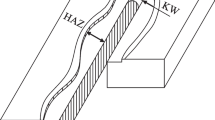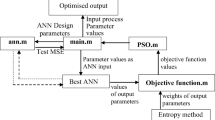Abstract
When using the Taguchi method, an L18 or L27 orthogonal array is usually adopted. However, this requires many experiments (18 or 27 runs, respectively), consuming time, and resources. This study proposes a progressive Taguchi neural network model, which combines the Taguchi method with the artificial neural network to construct a prediction model for a CO2 laser cutting experiment. During CO2 laser cutting, energy from the moving laser is accumulative. The paper develops an integral equation of energy density during laser beam movement and lets it determine the sliding level of control factor. Meanwhile, the paper proposes that in Stage 1, only less number of experiments is required to be conducted by L9 orthogonal array. After the crucial supplementary experimental training samples proposed in Stage 2 are also included, high-accuracy prediction of artificial neural network can be completed. Based on analysis from the progressive Taguchi neural network, the Stage 1 preliminary network—with only a few available experimental examples—has achieved good predictive ability from regions near the Taguchi control points. For regions further out, the predictions have been increasingly unreliable. Nevertheless, the high precision of Stage 2 Taguchi network has good predictive results for all regions.
Similar content being viewed by others
References
Coherent Inc. (1980) Laser operation, equipment, application and design. McGraw-Hill, New York
Peters CC, Marshall HL (1975) Cutting wood materials by laser. USDA Forest Service, Washington, DC, Paper 250
Nuss R (1988) Laser cutting of prim-polyurethane components in comparison with other cutting techniques. Proceedings of the Fifth International Conference on Laser in Manufacturing, September 13–14.
Rao BT, Kaul R, Tiwari P, Nath AK (2005) Inert gas cutting of titanium sheet with pulsed mode CO 2 laser. Optics Lasers Eng 43:1330–1348. doi:10.1016/j.optlaseng.2004.12.009
Todd JA, Copley SM (1997) Development of a prototype laser processing system for shaping advanced ceramic materials. J Manuf Sci Eng 119:55–67. doi:10.1115/1.2836556
Zhou BH, Mahdavian SM (2004) Experimental and theoretical analyses of cutting nonmetallic materials by low power CO 2 laser. J Mater Process Technol 146:188–192. doi:10.1016/j.jmatprotec.2003.10.017
Caiazzo E, Curcio F, Daurelio G, Minutolo FMC (2005) Laser cutting of different polymeric plastics (PE, PP and PC) by a CO 2 laser beam. J Mater Process Technol 159:279–285. doi:10.1016/j.jmatprotec.2004.02.019
Lum KCP, Ng SL, Black I (2000) CO 2 laser cutting of MDF: 1. Determination of process parameter settings. Optics Laser Technol 32:67–76. doi:10.1016/S0030-3992(00)00020-7
Syrcos GP (2001) Die casting process optimization using Taguchi methods. J Mat Proc Technol 135:68–74. doi:10.1016/S0924-0136(02)01036-1
Jeng JY, Wong YS, Ho CT (2001) Over-curing reduction of parts fabricated by the solid laser-diode plotter rapid prototyping system using the Taguchi method. Int J Adv Manuf Technol 18:683–691. doi:10.1007/PL00003962
Cherian RP, Smith LN, Midha PS (2000) A neural network approach for selection of powder metallurgy materials and process parameters. J Art Int Eng 14:39–44. doi:10.1016/S0954-1810(99)00026-6
Jain RK, Jain VK, Kalra PK (1999) Modeling of abrasive flow machining process: a neural network approach. Wear 231:242–248. doi:10.1016/S0043- 1648(99)00129-5
Lin SC, Ting CJ (1996) Drill wear monitoring using neural networks. Int J Mach Tools Manufact 36(4):465–475. doi:10.1016/0890-6955(95)00059-3
Tay KM, Butler C (1997) Modeling and optimizing of a Mig welding process- a case study using experimental designs and neural networks. Qual Rel Eng Int 13:61–70. doi:10.1002/(SICI)1099-1638(199703)13:2<61::AID-QRE69>3.0.CO;2-Y
Habaibeh A, Gindy N (2000) A new approach for systematic design of condition monitoring systems for milling processes. J Mater Proc Technol 107(1–3):243–251. doi:10.1016/S0924-0136(00)00718-4
Lin ZC, Yang CB (2010) Combining the Taguchi method with an artificial neural network to construct a prediction model of near field photolithography experiments. Proc IME C J Mech Eng Sci 224(10):2223–2233. doi:10.1243/09544062JMES2055
Kim DH, Kim DJ, Kim BM (1999) The application of neural networks and statistical methods to process design in metal forming processes. Int J Adv Manuf Technol 15:889–894. doi:10.1007/s001700050146
Inamdar M, Date PP, Narasimhan K, Maiti SK, Singh UP (2000) Development of an artificial neural network to predict spring back in air vee bending. Int J Adv Manuf Technol 16:376–381. doi:10.1007/s001700050169
Pilani R, Narasimhan K, Maiti SK, Singh UP, Date PP (2000) A hybrid intelligent systems approach for die design in sheet metal forming. Int J Adv Manuf Technol 16:370–375. doi:10.1007/s001700050168
Silfvast WT (1996) Laser fundamentals. Cambridge University Press, New York
Fowlkes WY, Creveling CM (1995) Engineering methods for robust product design: using Taguchi methods in technology and product development. Addison-Wesley, Reading
Fisher RA (1925) Statistical methods for research worker. Oliver & Boyd, London
Freeman JA, Skapura DM (1991) Neural networks: algorithms, applications, and programming techniques. Addison-Wesley, California
Author information
Authors and Affiliations
Corresponding author
Rights and permissions
About this article
Cite this article
Yang, CB., Deng, CS. & Chiang, HL. Combining the Taguchi method with artificial neural network to construct a prediction model of a CO2 laser cutting experiment. Int J Adv Manuf Technol 59, 1103–1111 (2012). https://doi.org/10.1007/s00170-011-3557-2
Received:
Accepted:
Published:
Issue Date:
DOI: https://doi.org/10.1007/s00170-011-3557-2




